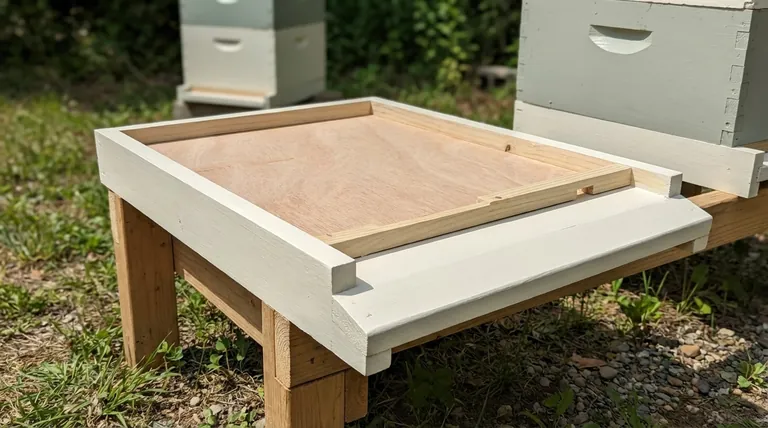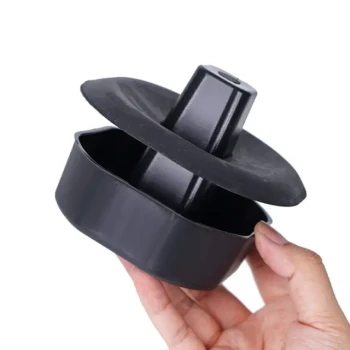Yes, you should paint the exterior of your beehive's bottom board. This is a critical step for protecting the wood from weather, moisture, and rot. However, this advice applies only to the parts of the board exposed to the elements, such as the landing strip and side edges; the interior surface where the bees live must be left unpainted.
The core principle is to protect your equipment from external weather while keeping the bees' internal living space as natural and chemical-free as possible. Proper painting is a simple but essential part of hive maintenance that directly impacts the longevity of your hardware.

The Role of the Hive Bottom Board
Before discussing maintenance, it's crucial to understand why the bottom board is so important. It's more than just a floor; it's a foundational component that influences the health, safety, and stability of the entire colony.
The Hive's Foundation and Entrance
The bottom board serves as the structural base for the entire hive. It provides a stable floor and creates the primary entrance and exit for the bees when a hive body is placed on top.
To prolong the life of the wood and prevent moisture from wicking upwards, the entire hive should be placed on a stand that keeps the bottom board off the damp ground.
Regulating Access and Defense
The entrance created by the bottom board is a key defensive point for the colony. For smaller or newly established colonies, an entrance reducer can be used to shrink the opening.
This makes it significantly easier for the guard bees to defend the hive against intruders like wasps, mice, or robbing bees from other colonies.
Best Practices for Painting and Protection
Properly preparing your bottom board is a one-time task that pays long-term dividends.
Painting for Weather Protection
You should paint all parts of the bottom board that are directly exposed to rain, sun, and snow. This includes the front landing area, the side rails, and the back edge.
A good quality, low-VOC exterior latex paint is a common and effective choice for this purpose.
Why You Must Leave the Interior Unpainted
The interior surface of the bottom board is the floor of the bees' home. They walk on it, deposit debris on it, and live in constant contact with it.
Introducing paint, and the chemicals it contains, into this internal space is unnecessary and potentially harmful to the colony. The wood does not face weather exposure inside the hive and does not require a protective coating.
Understanding the Trade-offs: Solid vs. Screened
The decision to paint applies to wooden bottom boards, but it's also important to know which type of board best suits your needs and climate.
The Solid Bottom Board
A solid bottom board is a simple, single piece of wood. Its main advantages are lower cost and potentially better heat retention.
This can be beneficial in colder climates, as it may help the colony begin raising brood earlier in the spring. The downside is that it requires manual cleaning to remove mites and debris.
The Screened Bottom Board
A screened or "integrated pest management" (IPM) bottom board features a wire mesh floor. This design provides superior ventilation, which is a major advantage in hot climates.
It also helps with pest control, as Varroa mites that fall off bees will drop through the screen and out of the hive. However, in cold climates, this extra ventilation may require the bees to work harder to keep the hive warm.
Essential Maintenance Beyond Painting
Your responsibility for the bottom board doesn't end after the paint dries.
Regular Cleaning is Non-Negotiable
For those using solid bottom boards, regular cleaning is critical for hive hygiene. Debris like wax cappings, pollen, and dead bees accumulate on the floor.
At least twice a year (early spring and late fall), you should set the hive bodies aside and use a hive tool or scraper to remove all the built-up debris from the bottom board.
Making the Right Choice for Your Hive
Your approach should be guided by your climate, beekeeping philosophy, and management goals.
- If your primary focus is cost-effectiveness in a cooler climate: A solid bottom board is an excellent choice; just be diligent about painting the exterior and performing regular cleanings.
- If your primary focus is mite management and ventilation in a warmer climate: A screened bottom board offers significant advantages, allowing mites to fall out of the hive and reducing heat stress.
- For all wooden bottom boards: The rule is universal—always paint the exposed exterior surfaces and elevate the entire hive off the damp ground to ensure its longevity.
Properly preparing and maintaining your bottom board is a simple investment that pays dividends in both equipment longevity and colony health.
Summary Table:
| Practice | Key Benefit |
|---|---|
| Paint the exterior | Protects wood from rain, sun, and rot |
| Leave the interior unpainted | Keeps the bees' living space chemical-free |
| Use a solid bottom board | Better for heat retention in cold climates |
| Use a screened bottom board | Superior ventilation and mite control in warm climates |
| Regular cleaning | Essential for hive hygiene and colony health |
Protect your investment and ensure your colonies thrive. Proper hive maintenance starts with the right equipment. HONESTBEE supplies durable, high-quality beekeeping supplies and equipment to commercial apiaries and beekeeping equipment distributors through our wholesale-focused operations. Let us help you build a stronger, healthier operation. Contact our team today to discuss your needs and explore our product catalog.
Visual Guide

Related Products
- Langstroth Solid Bottom Board for Beekeeping
- Langstroth Screen Bottom Board for Beekeeping Wholesale
- Australian Pine Wood Langstroth Screen Bottom Board for Wholesale
- Professional Drop-Style Hive Handles for Beekeeping
- Professional Engraved Round Hive Number Tags for Beekeeping
People Also Ask
- What is the purpose of a solid bottom board in a hive? Essential for Winter Survival & Insulation
- What is the recommendation for bottom boards in top bar hives? Choose the Right Foundation for Your Climate
- What factors should be considered when choosing between a solid and screened bottom board? Make the Right Choice for Your Hive's Health
- What frame setups are available for the solid bottom boards? Choose the Right Foundation for Your Hive
- What is the suggested approach for choosing hive boards if you have only 1 or 2 hives? Test Both Types to Find Your Perfect Fit.



















